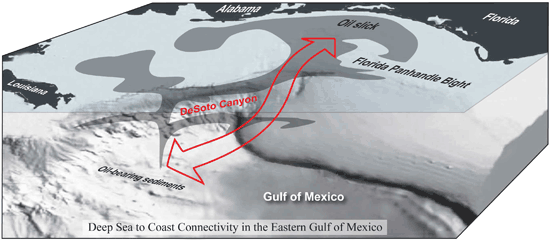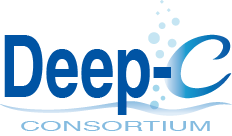About the Deep-C Consortium

The Deep-C (Deep Sea to Coast Connectivity in the Eastern Gulf of Mexico) Consortium is a long-term, interdisciplinary study of deep sea to coast connectivity in the northeastern Gulf of Mexico. The study is investigating the environmental consequences of petroleum hydrocarbon release in the deep Gulf on living marine resources and ecosystem health. Deep-C will examine the geomorphologic, hydrologic, and biogeochemical settings that influence the distribution and fate of the oil and dispersants released during the Deepwater Horizon (DwH) accident, and use the resulting data for model studies that support improved responses to possible future incidents.
The dual pressures in the northeastern Gulf of Mexico of expanding oil exploration in the outer continental slope and burgeoning population growth along the coast increase the risk of catastrophic discharges of oil and gas, over-enrichment of nutrients, and habitat loss. The region is considered a hotspot of biological diversity and has the highest biological productivity in the Gulf of Mexico so it has tremendous economic value. The DwH accident revealed that oil exploration activities can cause oil spills that affect a substantial part of the Gulf, and that the confluence of petroleum hydrocarbon release and water quality deterioration can have synergistic and negative effects on seafloor and pelagic ecosystems. It also brought to light a profound lack of understanding of the consequences of petroleum hydrocarbon release to the deep and shallow Gulf ecosystems, a deficiency that impairs the effectiveness of disaster response and mitigation efforts. Specifically, processes controlling the spatial and temporal distributions of oil components and dispersants, and the pathways through which petroleum hydrocarbons and their decomposition products move through the ecosystem are poorly quantified. The overarching goals of the Deep-C project, therefore, are (1) to generate quantitative data on the physical, chemical, and biological systems of the northeastern Gulf of Mexico including regions affected by the DwH spill such as the De Soto Canyon and the Florida Panhandle Bight; and (2) to integrate these data in both earth system and food web models that will improve prediction of the path, fate, and consequences of crude oil and gas released from the northeastern deep Gulf through natural or anthropogenic causes. This structure will ultimately allow the forecasting of changes in ecosystem services.
The project embodies elements of physical transport under average and extreme (e.g., hurricanes, hypoxia) conditions, defining chemical processes related to hydrocarbons originating from the oil spill and natural seepage, and describing the ecological interactions from microbial to benthic invertebrate and fish populations. Key questions relate to physical transport mechanisms, biogeochemical reactions, food web dynamics, and socioeconomic consequences. These include:
- What are the magnitudes, directions, and spatial and temporal scales of hydrodynamic processes that transport particles and dissolved substances (including oil, gas nutrients, solutes, and organisms) from the deep Gulf to the Florida Panhandle shelf waters in the northeastern Gulf of Mexico? How are these influenced by canyon and shelf topography?
- How does the transport of these particles and dissolved substances influence geochemical, biological, and demographic processes, including food web dynamics, across sea floor, pelagic, and near-shore ecosystems?
Integration of these data into earth system and food web models will allow simulations of oil spill scenarios, producing projections of changes in ecosystem services that can support decision making and forecasting of potential socioeconomic outcomes. The primary Deep-C research areas include:
- Geomorphology and Habitat Classification: To characterize sea floor geomorphology, bathymetry, sediment, and primary benthic habitats specific to the defined region with an emphasis on topographical features that influence deep sea to shelf connectivity.
- Physical Oceanography: To determine the effect of seasonal currents, topography, and episodic oceanographic or atmospheric drivers on the transport of oil, hydrocarbon gases, sediments, and organisms from the source region to sea floor and pelagic environments in the northeastern Gulf.
- Geochemistry: To assess the influence of oil and gas on water column and sediment biogeochemical processes and the distribution of substances that affect biological productivity.
- Ecology: To evaluate the biological diversity and trophic interactions among organisms ranging from primary producers to apex predators and from the deep-sea benthos to the coast. These data contribute to a food web model used to determine risks to ecosystem structure and function and regional economies following from extreme anthropogenic events (e.g., discharged and background hydrocarbon) and adaptive management strategies.
- Modeling: To develop a regional 3D Earth System Model that includes interfacial exchange processes between sediment, water, and atmosphere; biogeochemical processes, the transport of organisms, and the effects of petroleum hydrocarbons on all of these processes.
The combination of earth system and food web models will produce a powerful tool set that can be used to investigate and forecast environmental impact scenarios, and to assess the influence of hydrocarbon releases on fisheries, tourism, and human health. Making the connection between the productivity of the region (including the impacts of hypoxia, harmful algal blooms, fishing, habitat loss, and other anthropogenic impacts) and the physical oceanography of the system, is a major outcome.
Deep-C also includes a significant public education and outreach component to engage educators, students, policy makers, and the general public in an exploration of the connectivity of the physical, chemical, and biological realms of the Gulf of Mexico, as well as the various issues surrounding the protection of Gulf ecological communities. Education and outreach activities are taking place across all partner institutions, and including a Young Scholars Program for high school students, Research Experiences for Undergraduates and Teachers, diversity internships targeted toward under-represented populations, teacher workshops, and regional competitions. Deep-C research is also being communicated to a broader audience via e-newsletters and the Internet, as well as through presentations at community events.
Deep-C consists of ten major institutions that have been actively involved in assessing the impact of the DwH oil spill.
Deep-C was a four-year, interdisciplinary study of deep sea to coast connectivity in the northeastern Gulf of Mexico.Deep-C is no longer an active research project. The information on this website is for historical reference purposes only.
Home | About Us | Research Areas | Data Center | News & Multimedia | Education & Outreach
© Deep-C Consortium. All Rights Reserved.
This research was made possible by a grant fromThe Gulf of Mexico Research Initiative (GoMRI).
Copyright | Disclaimer | Privacy Policy
